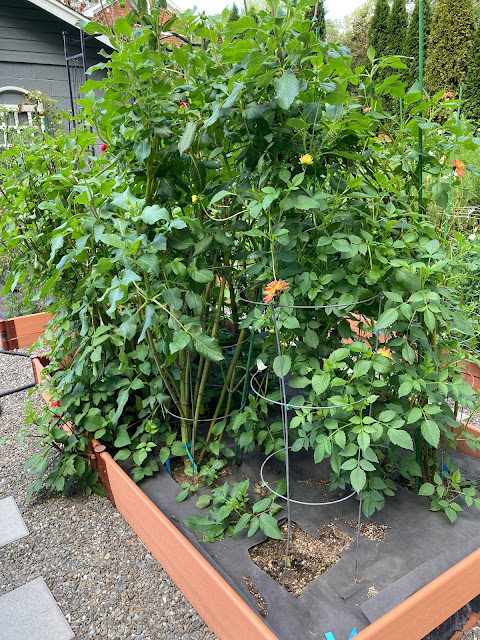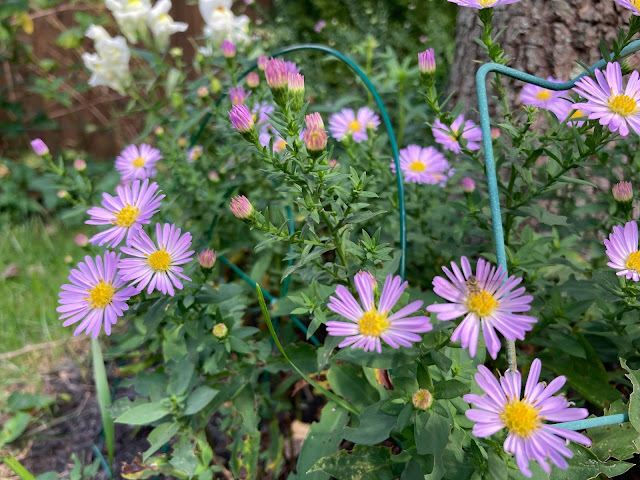September brought a mix of hot days and cool days, rain and sun. The garden is waning, as it always does in September, but I've kept a lot more plants longer than I have in past years so I consider it a win. This has been a really hard year in the garden, with a lot more work to defend it against pests and critters than any other year.
Tomatoes
I started pulling up the tomatoes in early September and continued as the plants waned. Black Krim was first, followed by the Roma paste and Tappy. Tappy didn't produce many tomatoes, and neither did the vine tomato. I think Tappy struggled with the white flies and blight (it consistently looked sick), but the vine tomato was a dud overall. It grew tall and leafy and grew up the archway, but overall was a dud production-wise.
Early Girl and Bushsteak Hybrid held on much longer, those had bumper crops that continued to ripen on the vine. Roma Paste and Black Krim also had bumper crops before they waned.
The cherry tomatoes grew up and over everything, using the other plants as support when they grew too long and became floppy from the rain and weight. I've left these in for now because they are still producing so much!
I am seriously considering just doing early girl, bushsteak hybrid, roma and cherry tomatoes next year.
The borage and marigolds being placed in the corners and ends of the bed worked really well for companion planting. The tomato plants get so big, it's the only way they can get enough light. Borage attracts pollinators and is supposed to help improve yields and I would definitely agree with this. Other than the two new tomatoes, we had massive numbers this year, which is even more impressive when you think about how many tomatoes the chipmunks stole early in the season.
Vines
I had to pull the cucumbers early. The white flies destroyed the vines, bringing in blight and death. The chipmunks ate most of the baby cucumbers before they had a chance to develop. In a normal year we have a lot of cucumbers, this year we had less than five overall. The melons did great this year (unlike last year), we had two big ones and one small one that all tasted amazing. I did pull the vine up after the last melon was harvested as it was withering quickly from a bad infestation of powdery mildew.
The bed still has carrots and swiss chard until frost. I like to give the carrots extra time so I'll pull those up in October and the chard loves the cool fall temperatures. I love the colors of rainbow chard too, even if you can barely see it with the nasturtium right now. As they do every September, the nasturtiums have exploded and are trying to take over the garden. Every year when this happens I tell myself that I'm only going to plant one next year, not two, because two is too many, and then I plant two again.
One thing I really missed this year? Pumpkins. In years past we've done big pumpkins and mini pumpkins and they are delightful... but they also attract terrible pests. In a year when we had a serious pest problem, it was probably for the best. And even if I do plant pumpkins next year, I might do it outside the garden somewhere else. The mini pumpkins were A DOLLAR EACH at Trader Joe's this week so I think those will be worth adding back in next year.
Mixed Flowers
This has been a great year for flowers, even with the pests (aka mites, white flies and blight). I have spent the season trying to only cut the flowers at the end of the day, to maximize the time the pollinators have with them. Especially this time of year when the days are shorter, colder and the butterflies are migrating. This has left me picking flowers at dusk in the near dark...
The snapdragons have been resistant to all the plagues (with the exception of greedy caterpillars) and bountiful. We've had a full rainbow of color and I get new blooms every few days. The zinnias do have a white fly and black mold problem, but they are full of blooms. I planted two rows of coral zinnias in two varieties (a regular zinnia and a cactus zinnia) and then a row of carnival mix that added orange, pink and magenta to the bouquets. It's a good combination.
The pink lemonade cosmos are still alive and producing like crazy, even with the blight trying to kill them - both plants are half brown but I picked an entire vase of flowers last night. The cold nights and cool days have changed the colors of the flowers from pale pink with a touch of yellow to yellow with a touch of pink - so cool! I've never had my cosmos last this long (usually by now they are dead from powdery mildew). Next year I want to try one of those apricot cosmos I've seen all over instagram -it's a peachy coral right in my shades of coral color scheme! Maybe I'll do one pink lemonade and one apricot? I think I've finally nailed down the right balance of flowers in this bed - 3 rows of zinnias, 2 cosmos and the other half snap dragons. The only edit I need to make is to move the globe amaranth to the corner on the snapdragon side, because it was crowded out by the cosmos.
Dahlias
This has been a wild ride with the dahlias. Hopefully this year's spider mite infestation was a fluke because I cannot go through this again. I spent HOURS and HOURS and H.O.U.R.S. trying to save my dahlias. Hand picking all the dead leaves off, removing dying leaves, spraying the entire plant (esp the impossible under side of the leaves!) with neem oil and insecticidal soaps EVERY THREE DAYS or after it rained, on repeat for weeks and weeks. It felt like a slow motion train wreck, a war against spider mites that I was helpless against and destined to lose. I sprayed until I ran out of neem oil and soap from the big concentrated jugs and then just sat back to let nature take its course because there was nothing more I could do. The plants looked worse and worse, a few died, and then... the weather changed.
New growth appeared on the more mature plants. Some of the bulbs sprouted new shoots. And they slowly started to come back. Not all has been lost! Some are even blooming again, though my bloom count was probably 1/8-1/4 of what it normally is in September since this is supposed to be peak season right now. But most of them are STILL ALIVE and I was really at the point where I thought all would be lost.
I did lose multiple plants, especially smaller younger tubers that just didn't have enough reserves to survive the infestation. And some older tubers that were just hit much harder. I lost more than half my Thomas Edison, a couple Cornell Bronze, American Dawn, Totally Tangerine, Waltzing Matilda, Labyrinth, Fascination, and several Dalinovas... but these are not completely gone because I still have at least one living tuber. Hopefully these will survive overwintering after their trauma and we can resuscitate my collection next year. I did completely lose Apricot Desire, Fairway Spur, Advance (new this year), and Que Sera (new this year). But considering I thought I would lose EVERYTHING, all that work and TLC did pay off. (Though I can totally see why the default answer is throw away the plants because OMG that was a whirlwind of destruction.)
Herbs and Strawberries
This has been an AMAZING year for herbs. Lavender, calendula (planted and self-seeded), rosemary, basil, dill, oregano, thyme, sage, borage (planted and self-seeded), lemon balm (which is great in its pot and self-seeded EVERYWHERE), lemongrass (also potted), lemon verbena (potted). I've been drying bundles of herbs like crazy, drying flowers, binding smudge sticks, making freezer pesto and freezing chopped fresh herb blends in olive oil in ice cube trays for winter.
The two giant sunflowers in here fed the birds and chipmunks and looked beautiful. Sunflowers are so cheerful. I need to pull up the remains on my next round of garden cleanup. I'm hoping next year the strawberry harvest goes better now that our garden is fortified against chipmunks.
Pots
The herbs in pots have been excellent this year, just like the planted ones. They don't look great in the photo because they were recently harvested. The hot peppers are coming in now in abundance, much to Mike's joy since he loves spicy foods and these cayenne peppers and habaneros have a nice kick.
My morning glory looks like garbage again this year. I also don't see any blooms. I guess next year it's time to try something else. Black eyed susan vine? Should I try to grow mini pumpkins in a pot up the trellis? Hyacinth vine? There are so many options. My flower pots this year were a mixed bag too, I think it was the weather and that might be part of the morning glory's struggle. Some things like my begonias did amazing across the board. And then my other pots with mixes of flowers were all over the place - coleus in some pots looks beautiful and is almost dead in others. Snapdragons and geraniums half dead in one pot and thriving in another. My jasmine, which has been struggling for the past couple of years (and was so bad I almost pulled it last fall), had its best summer ever. Everything is all over the place.
Elsewhere in the yard
Figs! It's the season of figs... and raspberries? No clue why we had a small harvest of raspberries in LATE SEPTEMBER, but they were an unexpected boon. We had a small handful every day for a week. So odd. I'm checking the fig tree for more ripened figs every few days. It's a lower harvest year in the cycle, last year was a high yield year and I can't remember if this tree has a 2 year cycle or a 3 year cycle... next year will either be a lot again, or the year after. But either way we still have plenty of figs for snacking.
The blackberries finished but we had a ton again this year. And the birds don't seem to eat them so more for us! The elderberry bushes are recovering from the deer coming through and eating more than half of them (this year has been nature gone wild, not only did we have a deer in our yard for the first time in over a decade, but we HAD A BLACK BEAR ON OUR STREET a couple weeks ago and we literally RAN INTO IT WHILE WALKING THE DOG! We don't have woodland large enough to support a bear nearby, so it must have just been passing through, so it was quite unexpected!). The citrus trees are at the point where they are outside during the day and need to come in most nights, and are kind of yellow now because I forgot to bring them in a couple times when it dipped below 45 degrees. They need to come in permanently soon but it's a bit early and the more sun they can get, the better.

























No comments:
Post a Comment